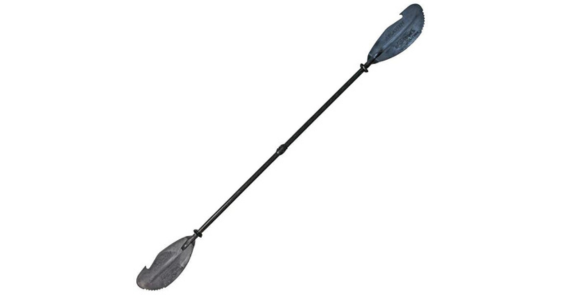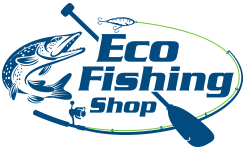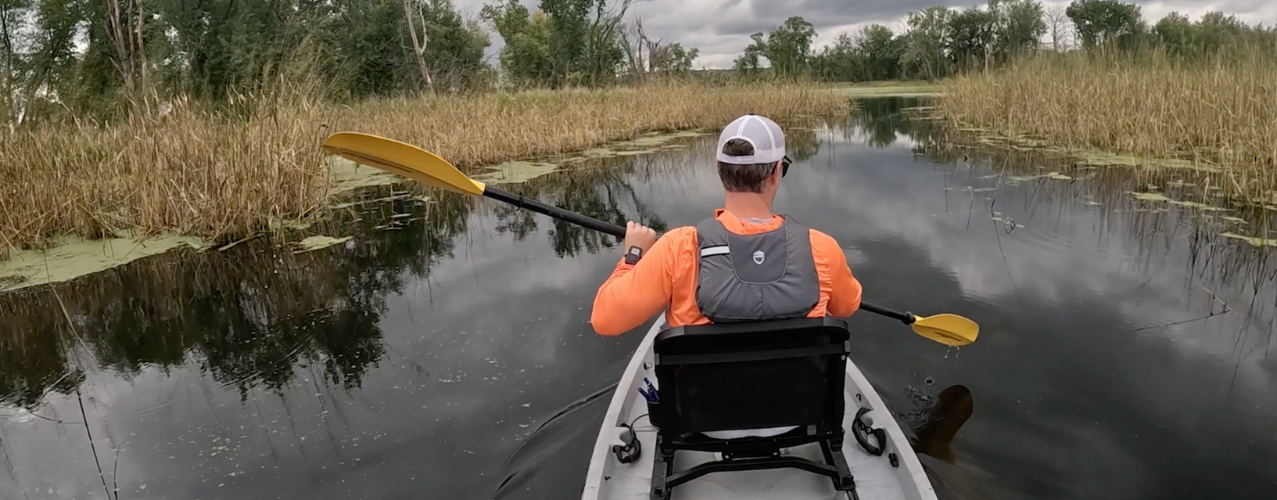Essential Gear for Kayak Fishing: Paddles
Two of the most important items on your kayak are often the most overlooked. A good life jacket and an efficient paddle are typically forgotten about as two of the most important pieces of kayak fishing equipment that most directly enhance your time spent on the water.
In our experience, kayak paddles in particular typically aren't even on a customers mind when planning out their budget and kayak purchase. As you consider a kayak paddle that best suits how you will use your kayak, we will address the following questions: What is the correct kayak paddle length? What types of paddles are there? What are other factors to consider when buying a paddle? Let's break some of those questions down. Scroll to the bottom of the page to view our most recent episode on Kayak Fishing Paddles as well.
What is the Correct Kayak Paddle Length?
Many of you, like me as well, have probably searching sizing charts. You have probably found kayak paddle size charts difficult and frustrating. What further complicates paddle sizing for fishing kayaks is many have elevated seats and are much wider than traditional kayaks. All of these can lead to needing a paddle that is longer than a typical size chart will point you to. In our podcast video below, Johnathan explains a more straight-forward, albeit unscientific, way of predicting your paddle size.
Johnathan says, "When you are standing on the ground, you should be able to reach the top of the paddle standing on one edge next to you." To put it clearly, stand a paddle next to you and if you can reach the top of your paddle you are in the ballpark for the correct size. Here are a few more generic rules to help guide you in addition to those pesky charts:
-
Kayak Width: The width of your kayak is a significant factor. Wider kayaks require longer paddles to reach the water comfortably. Measure the width of your kayak at its widest point.
-
Your Height: Taller paddlers generally require longer paddles, while shorter paddlers will need shorter ones. However, there's no strict formula, as personal preference and paddling style also play a role.
-
Paddle Length Calculation: There are various methods to calculate paddle length. One common method is: Situate the paddle vertically beside you with the blade resting on the ground. Reach your arm straight up above your head. Your fingers should touch the top of the paddle. If they do not, the paddle is too long or too short. (ballpark estimate)
-
Paddling Style: Consider your paddling style and the type of kayaking you'll be doing. For instance, if you're into high-angle paddling (more aggressive strokes), you might prefer a slightly shorter paddle for better control and power. Low-angle paddling, typically used in recreational kayaks, often requires longer paddles for smoother strokes.
-
Blade Angle: The angle of the blade affects how efficiently you move through the water. High-angle paddling usually requires blades with a higher angle to the shaft for more power, while low-angle paddling uses blades with a shallower angle for smoother, more relaxed strokes.
-
Adjustability: If you're uncertain or if you plan to share the paddle with others, consider an adjustable paddle. These allow you to modify the length to suit different kayakers or different kayak widths.
-
Trial and Error: Ultimately, the best way to find the right paddle size is through trial and error. Borrow paddles from friends or rent them from a kayak shop to test different lengths and styles. See what feels most comfortable and efficient for your paddling style and body size.
Let's look closer at adjustability. If you are newer to kayak fishing, or you own multiple fishing kayaks, having an adjustable paddle can take some of the stress out of deciding which length is best for you. If you are unable to get into a shop and demo the kayak and paddle combo you want, buying an adjustable paddle is a great option. We always recommend starting smaller and more affordable when you aren't sure of the correct size. You can dial in your adjustable paddle and upgrade later knowing exactly the right length of paddle that you will need.
What Kind of Kayak Fishing Paddle is Best?
There are a few different paddle types and each has their own benefits. Let's quickly go through each type and a few of their pros & cons.
Fishing kayak paddles typically come in three different materials: Aluminum, Carbon Fiber and Fiberglass. Let's take a quick look at each.
Aluminum
Aluminum paddles are affordable and durable. They are relatively heavy compared to other materials, which can make them less desirable for longer paddling trips.
Pros:
- Aluminum paddles are typically the most budget-friendly option, making them accessible to beginners or those on a tight budget.
- They are highly resistant to impact and abrasion, making them suitable for rugged conditions and rocky environments.
- Aluminum paddles require minimal maintenance and can withstand exposure to water without corroding or degrading.
Cons:
- Aluminum paddles tend to be heavier than other materials, which can cause fatigue during extended paddling sessions.
- The weight and flexibility of aluminum paddles can reduce efficiency and make it harder to maintain a consistent paddling rhythm.
- They may not offer the same level of performance or responsiveness as lighter materials like fiberglass or carbon fiber.
Fiberglass
Fiberglass paddles are lighter than aluminum and offer better performance. They are more durable than some other materials and tend to be a popular choice among kayakers for their balance of weight, durability, and cost.
Pros:
- Fiberglass paddles are lighter than aluminum, reducing fatigue and making them more comfortable for long paddling trips.
- Fiberglass offers a good balance of stiffness and flex, providing efficient power transfer and responsiveness.
- Fiberglass paddles are durable enough to withstand moderate impacts and abrasion, making them suitable for various conditions.
Cons:
- Fiberglass paddles tend to be more expensive than aluminum or plastic options, which can be a barrier for budget-conscious buyers.
- While fiberglass is relatively durable, it can crack or break under heavy impacts or misuse, requiring repair or replacement.
- Although stiffer than aluminum or plastic, fiberglass paddles may not offer the same level of stiffness and efficiency as carbon fiber.
Carbon Fiber
Carbon fiber paddles are the lightest and stiffest option available. They offer excellent performance and are preferred by serious kayakers for their efficiency and responsiveness. However, they tend to be the most expensive option.
Pros:
- Carbon fiber paddles are exceptionally lightweight, reducing fatigue and allowing for faster strokes and greater efficiency.
- Carbon fiber offers the highest stiffness-to-weight ratio, providing excellent power transfer and responsiveness for more efficient paddling.
- Carbon fiber paddles are favored by serious kayakers for their superior performance, making them ideal for competitive or long-distance paddling.
Cons:
- Carbon fiber paddles are the most expensive option, often priced significantly higher than aluminum or fiberglass paddles.
- While strong and stiff, carbon fiber can be brittle and susceptible to damage from impacts or improper handling.
- Carbon fiber paddles may be less readily available compared to aluminum or fiberglass options, especially in remote areas or smaller markets.
Other Factors to Consider
Before we jump into some kayak paddles and our most recent podcast from Hooked! The Kayak Anglers Resource, let's look at a few more advanced factors to consider when looking at a fishing kayak padddle.
Feathered vs. Unfeathered Paddles
Feathering refers to the offset angle between the two blades of the paddle. Feathered paddles are adjustable, allowing the paddler to rotate one blade relative to the other. This can reduce wind resistance on the non-active blade during the recovery phase of the stroke, which can be beneficial in windy conditions. Unfeathered paddles have both blades aligned in the same plane and are typically preferred by beginners or those who prioritize simplicity.
High-Angle vs. Low-Angle Paddles
These terms refer to the angle at which the paddle enters the water relative to the surface. High-angle paddles are designed for a more aggressive paddling style, typically used in whitewater or for faster cruising speeds. Low-angle paddles are more suited for relaxed paddling and are often preferred for touring and recreational kayaking.
Fishing Kayak-Specific Paddle Traits
Fishing paddles are specialized for kayak fishing. They may come with additional features such as built-in measurement markings, hook retrieval notches, serrated teeth for pushing off, or even a blade designed to function as a makeshift anchor.
Kayak Fishing Paddles

YakGear Backwater Assassin Carbon Fiber Paddle
The Assassin was designed for both high angle and low angle paddlers. The oversized blade helps to pull a lot of water when paddling and makes turning even easier. The shaft is carbon hybrid to reduce overall weight and the oversized ABS injected nylon blade is hard enough to push off on any surface and not crack or flex.
$125
Shop Now

Easy Tourer GS Vario Fiberglass Paddle
Durable low-angle paddle with nylon blades and a fiberglass shaft. Now with 360º angling and telescopic length 210-240cm. This paddle is light, with durable nylon blades oval rubber grips over the fiberglass shaft, and is equipped with drip rings. The shape of the blade is for primarily low-angle strokes.
$135
Shop Now

Old Town Carlisle Magic Angler Paddle
Designed for kayak anglers, the Carlisle Magic Angler is a lightweight, efficient and powerful paddle, with angler specific features. The asymmetrical, slightly curved blade shape, combined with a lightweight, flexible fiberglass shaft produces smooth yet powerful strokes. A cutout in the blade is used to free snagged hooks and the ruler on the shaft can be used to measure your catch!
$129.99
Shop Now

Bending Branches Angler Scout Paddle
The paddle designed to take on abuse while improving the fishing experience with a 40-inch tape measure and hook retrieval system. Built to take tough knocks, the Scout provides beat-it-up durability at a wallet-friendly price with epX engineered polymer blades and ovalized aluminum shaft. A built-in hook retrieval system and a tape measure on the shaft for a perfect sizing guide.
$129
Shop Now

Kokopelli Alpine Lake Paddle
The Lake Paddle is made of an impact resistant nylon composite blade and a fiberglass shaft and is easy to assemble, pack, and use on the water. The center ferrule (joint) and shaft to paddle ferrule is a traditional stainless steel button system for an easy secure fit.
$93.50
Shop Now

Solstice 4-piece Quick Release Paddle
The Solstice 4-piece quick release paddle is great for beginners or for those looking to add a second paddle. Made of aluminum the 4-Piece quick release has 3-Position adjustability and is compact for storage and travel. The outdoors awaits, dip your blade and take off.
$36.75
Shop Now
Hooked! The Kayak Anglers Resource: What We are About & Links
Hooked! The Kayak Anglers Resource is your one-stop resource for all things fishing kayaks. Watch, listen and engage with kayak anglers like you. Our experts cover everything from kayak fishing for beginners, fishing kayak accessories to fishing kayaks with a motor. Whether you are new to the sport or an experienced kayak angler looking to learn new tricks, the Kayak Anglers Resource aims to help every kayaker of all levels of experience.
Learn More From Our Blogs
Join Our Online Community of Anglers
It is easy to get wide eyes when dreaming of your perfect kayak setup. We see some of the craziest setups around in our line of work. But, those kinds of advanced setups with all the bells & whistles are not necessary for everyone. Sometimes, it is easier to take fellow kayakers' word for it rather than a retailers. That's why we created the Kayak Anglers Resource - a community of kayak anglers who share their experiences, ask questions and give honest reviews and assessments of kayaks and accessories. We can share our expertise until we are blue in the face, but a fellow anglers words often mean more.
Here a few great examples of how kayak anglers are helping other kayak anglers make better decisions on their purchases:
Follow & Subscribe to Our Social Channels










